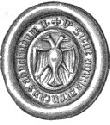
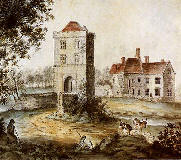

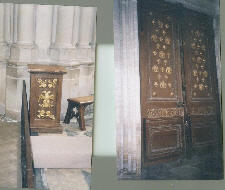

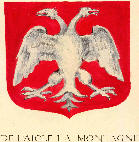

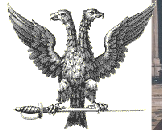



TWO-HEADED EAGLE - At Bayeux; Crest of the de l’Aigle’s ( in red - de l’’Aigle la Montagne as brought to America by Nicolas de l’Aigle) ; Michelham-1791 - built by Gilbert De l’Aigle Signet de Aquila Chateau de l’Aigle
Norman de l’Aigle’s (page 2)
Before I continue with the genealogy of the de l’Aigle’s - I post in the following pdf file information compiled on de l’Aigle HOLDINGS in ENGLAND, and the Honour of the Eagle. I welcome additions and corrections to this information.
The children of Engengulf de l’Aigle and Richvaride (Richeride)
Richer I de l’Aigle, 3rd baron de l’Aigle, was born between 1039/1045, and was killed 18 Nov 1085 in St. Suzanne, Maine, France. Richer is said to have been “always faithful,” and served in all the wars of the Norman dukes. During the long siege of the fortress of Holy Suzanne, Richer was out walking when a child of about 10 or 12 who was hiding in the shrubby shot him with an arrow that hit under his eye, wounding him mortally. The friends of Richer wanted to kill the child, but Richer forgave him, stating: "For the love of God, leave to go it; this is as well as I must die for the expiation of my failings." Then, a priest being unavailable, Richer confessed his sins to his companions and died. His body was buried in the convent of Saint-Sulpice, his death causing deep mourning of his parents and of its friends. Richer married Judith (le Goz) D' AVRANCHES.
Gilbert de l’Aigle (died 1092) , was commanded by Robert III duke of Normandy to perform military service "because he was conspicuously courageous" and rewarded him with the castle of Exmes, which was immediately besieged by Robert de Bellême, and so continued the feud with the Belleme’s. He launched an attack on the castle of Sainte-Suzanne to avenge the death of his brother, Richer. He was, not long after, killed as he was returning home from a visit to Sainte Scholasse, where he had halted at Moulins-la-Marche to pay his respects to Duda, daughter of Waleran, Earl of Meulent, and second wife of William de Moulins, lord of that castle, and leaving towards evening unarmed and attended only by his esquires, was seen and pursued by Gerrard Chevreuil and Robert de Ferrers, with some thirteen men-at-arms of the Corbonnais, who endeavoured to take him alive. He spurred his horse to a gallop, but was overtaken and wounded in the side by one of their spears so badly that he died the same day, and on the morrow, which was bissextile-day (29th of February, 1092), he was buried at St. Sulpice, by the side of his parents, amid universal sorrow, Gilbert, Bishop of Evreux, and Serlo, Abbot of St. Evroult, officiating. Orderic said of Gilbert that his death, "was deservedly regretted by his acquaintance for the many virtues with which he was endowed. In person he was strong, handsome, and active; a faithful observer of the divine laws, courteous and humble with men of religion, prudent and eloquent in worldly affairs, and gentle and liberal in all his conduct." Gilbert "Aquila" is recounted in Rudyard Kipling's "Puck of Pook's Hill."
Roger de l’Aigle was called “a young man of the most beautiful hope,” who died young in 1059. “One is unaware of the place and the cause of his death.” After his death his grieving parents “spent some time at Saint- Evroult,” in a effort to relieve their pain, and donated his horse to the convent, who gave it to Baudric for his good-will; the family also gave some land to the Benedictine convent Saint Lomer de Blois, if I understand the French correctly.
Robert de l’Aigle is mentioned in "Historie des Antiquites de la ville de l'Aigle et des ses environs," where it says: “one does not know it that by a charter in which Richer confirms several gifts that Engenouf, his father, and its slaves had done has Holy Evroult, the very day that the church was dedicated, by Gilbert bishop of Lisieux, Gilbert bishop Evreux, and Serlon bishop of Seez, in their presence, of Richerede mother of Richer, of Gilbert and his brothers. Kathleen Thompson names Robert as a son of Engenulf.
Roger de l’Aigle was called “a young man of the most beautiful hope,” who died young in 1059. “One is unaware of the place and the cause of his death.” After his death his grieving parents “spent some time at Saint-
Robert de l’Aigle is mentioned in "Historie des Antiquites de la ville de l'Aigle et des ses environs," where it says: “one does not know it that by a charter in which Richer confirms several gifts that Engenouf, his father, and its slaves had done has Holy Evroult, the very day that the church was dedicated, by Gilbert bishop of Lisieux, Gilbert bishop Evreux, and Serlon bishop of Seez, in their presence, of Richerede mother of Richer, of Gilbert and his brothers. Kathleen Thompson names Robert as a son of Engenulf.
The children of Richer de l’Aigle, 3rd baron de l’Aigle, & Judith (le Goz) D' AVRANCHES.
Gilbert II (Gislebert) de l’Aigle, 4th baron de l’Aigle was born ca 1061, died 1118. Gilbert lived during the disruption caused by the death of Guillaume the Conqueror and the division of his succession. He went to the “relief of the Hyesmes count, his uncle, and pushes back Robert de Bellesme,” who was besieging him. His uncle Gilbert was killed (1092). Gilbert fought against Robert de Bellesme and Guillaume de Breteuil for Robert Courte-Heuse at Rouen. He fought next against the French and le Manceaux and again against Robert de Bellesme. He ended up taking the part of Henri I, and received him at the Castle de l’Aigle. Gilbert married Julianne du Perche of Mortagne, daughter of Geoffrey II du Perche, Count of Perche Mortagne & Beatrice de Montdidier. “In about 1091(2), after his knights had murdered Gilbert de l'AIGLE, Count Geoffrey of Mortagne pacified the injured party by marrying his daughter to the dead man's nephew, the lord of l'AIGLE, and according to Orderic Vitalis the resulting 'alliance between the two lines of cousins' (foedus inter consobrinos heredes) became the bedrock for maintaining peace in this region for many years afterwards; a generation later, the cooperation of Count Rotrou II of Perche and RICHER II de l'AIGLE in extorting vital border fortresses from King Stephen in 1137 shows that their kinship was still the fulcrum of politics in this part of the Norman march. The l'AIGLE family may well have ." Their marriage provided the de l’Aigle family with “powerful support and some remarkable family connections. Juliana, an interesting figure in her own right, who possessed a personal library, retained close links with her family, standing in for her brother, Rotrou, while he campaigned against the Moslems in Spain in the 1120’s.” [Much can be found about Gilbert and the Honour of the Eagle in England. (see pdf file above).
Engenulf de Laigle. He is named and his parentage given by Orderic Vitalis, which specifies that he died before his father. Richer would have been about 40-45 when he died, so Engeneulf was apparently young when he died states he “died without heirs.” .
Matilda (Maud) de l’Aigle, (born about 1078, died after 1130) married first Robert de Mowbray [Montbrai]. Robert was appointed Earl administrator of Northumberland in 1080/81. He allegedly governed badly and with cruelty. He plotted against William II King of England in 1088. He defended Northumberland against incursions from Scotland, culminating in the Scottish defeat at Alnwick in 1093 with King Malcolm III and his eldest son were killed. Robert rebelled against King William II again in 1095, supporting a conspiracy aimed at placing Etienne Comte d'Aumâle on the English throne. He was eventually captured, deprived of Northumberland and imprisoned at Windsor. He spent about 34 years in prisons "growing old without offspring", then was allowed to become a monk at St Albans. Matilda de AQUILA did not sorrow very long for her husband. Matilda married second Nigel (Nele) d'Aubigny (de Albini). According to a principle of jurisprudence still prevailing in France, and adopted from the Roman law, perpetual imprisonment is equivalent to civil death: the Pope therefore declared the marriage dissolved. Another husband soon appeared, Nigel de Albini, the King's Bow-bearer, who, obtaining Earl Mowbray's wife and Earl Mowbray's lands, transmitted Earl Mowbray's name to his posterity. Nigel lived with Matilda as long as she could promote his interest; but when her brother, Gilbert de Aquila, died, even as she had divorced her first husband, so did the second divorce, using the excuse of consan Nigel kept the lands, but repudiated the lady. Matilda died in disgrace and poverty; and Nigel, by Henry Beauclerk's special intervention, married the great heiress, Gundreda the Fair, daughter of Gerard de Gournay; and his son Roger, assuming the name of Mowbray, though without a drop of Mowbray blood in his veins, became the founder of the new Mowbray family." It is possible that she had a son by Nigel, who was Hamon de Aubigny, born in Derbyshire, England, but I have no proof of this.
Actually, I don’t believe Matilda died in total disgrace and poverty at all. We find a fascinating glimpse of her in Dorset: One of the well-known de l’Aigle properties in England, Wynford Eagle in Dorset, has a little church, St. Lawrence’s of Wynford Eagle, in which is preserved “a striking Norman tympanum carved with two wyverns, probably intended to represent eagles, as a pun on the name of MATILDA de LAIGLE, who presumably commissioned it.” We see that she was living in 1130, and was probably a resident in Dorset, where her “demesnes, apparently 14 hides, are exempted from Danegel in the same yet. Her Dorset estates were Winford and Little Toller,the former still known as Winford Eagle, and the latter usually called Toller Fratrum, by reason of its sometime possession by Knights Hospitallers of St. John, on which order it was bestowed by Matildis herself, or one of her kindred.”
a son: HAMON
Richard de l’Aigle - Richard II (often Richard I of Aquila) (d.1111) was the consul and duke of Gaeta, ruling from 1104 or 1105 to his death. • He conquered the duchy from his predecessor, William Blosseville, whom he exiled. He subsequently minted his own coinage as an independent prince. In 1103, William Blosseville conquered the city and in turn was conquered by Richard of Aquila in 1105. Richard was a de facto independent duke as were his successors. • He lent troops to Pope Paschal II in 1108 to retake Rome. He was a constant ally of the pope and enemy of Ptolemy I of Tusculum.
Richard’s wife was Rangarda 1104 : Riccardo dell Aquila normanno, conte di Fondi e di Sessa, mort nel governo verso l'anno 1111 : ebbe per moglie Rangarda, che gli partori due figli Andrea e Pellegrino. Children: 1) Andrea (Andrew) and 2) Pellegrino. Possible other child: Goffredo. “Di questi disordini profittavano quei torbidi Signori feudali, che erano sempre in sulle armi a procacciarsi nuove terre a danno dei piu deboli, o dei piu travagliati, e sempre vigili a spiare l'occassione che favorevole loro si porgesse per occupare quelle della Badia. E n'era il temp: per la qual cosa Goffredo figliuolo di Riccardo dell'Aquila,” (etc) ......about 1126
Rough translation: “Of these you disorder they made progress those cloudy feudal Signori, that were always (about) to arm to obtain itself new lands to damage of the (most) weak, or of the (more/most) tormented, and always (alert/prudent/on guard) to spy on occasions that (were) favorable they it is offered to occupy those of the Minds. And n' was the temp: for it which does ,” (etc) .........about 1126
... By Matteo Camera
Sotto il dominio de Normanni, Riccardo I dell'Aquila, conte di Fondi e di Sessa della stirpe de Principi di Capua, arrivo a governare questa ducea. Ne ignoriamo il modo ed i mezzi da lui praticati. E certo pero che nell' anno 1063 trovansi notati ne diplomi Riccardo ed il suo figlio Giordano come duchi di Gaeta. Dopo la morte di quest' ultimo, pervenne il ducato a Gionata, signor di Carinola (di cui ignoriamo se gli fusse stato figlio), il quale morte in eta giovanile. RICCARDO II, figlio di Bartolomeo conte di Carinola e suo successore, ebbe nel 1125 a contendere ___ Rangarda, vedova del succitato Riccardo dell'Aquila, pel Ducato di Gaeta. In___ essendo mancata vivere senza prole Richardo II, questo Ducato divenne una semplice Signoria e posseduto come patrimnio da altri personaggi.
Under the dominion it says Norman, Riccardo I dell' Eagle, counts of Fondi and of di Sessa of the stock says starts of Capua, arrives to govern this (duchy). We are unaware of the manner and the means from him put into practice. And certain pear tree than in the year 1063 trovansi noted you graduate of it Riccardo and its Jordanian son like duchi of Gaeta. After the death of quest' last, pervenne the ducato to Gionata, signor of Carinola (of whom we are unaware of if the fusse been son), which death in youthful eta. RICCARDO II, son of Bartolomeo counts of Carinola and its successor, had in 1125 to dispute ___ Rangarda, widow of the above-mentioned Riccardo dell' Eagle, pel dukedom of Gaeta. In___ having been lacking to live without offspring Richardo TWO, this dukedom divenne a simple Signoria and possessed like patrimnio from other characters.
There was another Richard di Aquila after this original Richard, Conte di Fondi.... Perhaps a child of Andrea or Pellegrino? I believe that Richard (II) married “Matilda” - possible sons: Roger and Robert.
: “The Ryccardus de Sancti Germano Annales record that Diepold's brother Siegfried was among those captured by Gauthier de Brienne at the battle of Canne 25 Oct 1202. m (1199) --- di Aquila, daughter of RICCARDO di Aquila Conte di Fundi & his wife ---. The Ryccardus de Sancti Germano Annales record the marriage in 1199 of "Ryccardus de Aquila Fundanus comes…filiam suam" and "Sifrdio fratri comitis Dyopuldi" arranged by the bride's father in order to ensure the safety of his lands.” In 1145, Hillock then feudo di Fondi, passed under the dominion of the family of the Aquila, Conti di Fondi. Of this family the last heir was Giovanna Of Aquila (1299), daughter of Riccardo Conte di Fondi and Giacoma Ruzzo of Conti of Catanzaro. The Castle therefore could fregiarsi of the facoltosa and powerful family of the Aquila, of which very soon Giovanna Of the Aquila married Loffredo Caetani, of the Caetani family (original of Gaeta) powerful Getlteman of the feudi from di Fondi to Sermoneta.
“OTHER SONS & DAUGHTERS” [ of Richer & Judith] are mentioned by Orderic.
-----------------------------------------------------------------------------------------------------
Engenulf de Laigle. He is named and his parentage given by Orderic Vitalis, which specifies that he died before his father. Richer would have been about 40-
Matilda (Maud) de l’Aigle, (born about 1078, died after 1130) married first Robert de Mowbray [Montbrai]. Robert was appointed Earl administrator of Northumberland in 1080/81. He allegedly governed badly and with cruelty. He plotted against William II King of England in 1088. He defended Northumberland against incursions from Scotland, culminating in the Scottish defeat at Alnwick in 1093 with King Malcolm III and his eldest son were killed. Robert rebelled against King William II again in 1095, supporting a conspiracy aimed at placing Etienne Comte d'Aumâle on the English throne. He was eventually captured, deprived of Northumberland and imprisoned at Windsor. He spent about 34 years in prisons "growing old without offspring", then was allowed to become a monk at St Albans. Matilda de AQUILA did not sorrow very long for her husband. Matilda married second Nigel (Nele) d'Aubigny (de Albini). According to a principle of jurisprudence still prevailing in France, and adopted from the Roman law, perpetual imprisonment is equivalent to civil death: the Pope therefore declared the marriage dissolved. Another husband soon appeared, Nigel de Albini, the King's Bow-
Actually, I don’t believe Matilda died in total disgrace and poverty at all. We find a fascinating glimpse of her in Dorset: One of the well-
a son: HAMON
Richard de l’Aigle -
Richard’s wife was Rangarda 1104 : Riccardo dell Aquila normanno, conte di Fondi e di Sessa, mort nel governo verso l'anno 1111 : ebbe per moglie Rangarda, che gli partori due figli Andrea e Pellegrino. Children: 1) Andrea (Andrew) and 2) Pellegrino. Possible other child: Goffredo. “Di questi disordini profittavano quei torbidi Signori feudali, che erano sempre in sulle armi a procacciarsi nuove terre a danno dei piu deboli, o dei piu travagliati, e sempre vigili a spiare l'occassione che favorevole loro si porgesse per occupare quelle della Badia. E n'era il temp: per la qual cosa Goffredo figliuolo di Riccardo dell'Aquila,” (etc) ......about 1126
Rough translation: “Of these you disorder they made progress those cloudy feudal Signori, that were always (about) to arm to obtain itself new lands to damage of the (most) weak, or of the (more/most) tormented, and always (alert/prudent/on guard) to spy on occasions that (were) favorable they it is offered to occupy those of the Minds. And n' was the temp: for it which does ,” (etc) .........about 1126
... By Matteo Camera
Sotto il dominio de Normanni, Riccardo I dell'Aquila, conte di Fondi e di Sessa della stirpe de Principi di Capua, arrivo a governare questa ducea. Ne ignoriamo il modo ed i mezzi da lui praticati. E certo pero che nell' anno 1063 trovansi notati ne diplomi Riccardo ed il suo figlio Giordano come duchi di Gaeta. Dopo la morte di quest' ultimo, pervenne il ducato a Gionata, signor di Carinola (di cui ignoriamo se gli fusse stato figlio), il quale morte in eta giovanile. RICCARDO II, figlio di Bartolomeo conte di Carinola e suo successore, ebbe nel 1125 a contendere ___ Rangarda, vedova del succitato Riccardo dell'Aquila, pel Ducato di Gaeta. In___ essendo mancata vivere senza prole Richardo II, questo Ducato divenne una semplice Signoria e posseduto come patrimnio da altri personaggi.
Under the dominion it says Norman, Riccardo I dell' Eagle, counts of Fondi and of di Sessa of the stock says starts of Capua, arrives to govern this (duchy). We are unaware of the manner and the means from him put into practice. And certain pear tree than in the year 1063 trovansi noted you graduate of it Riccardo and its Jordanian son like duchi of Gaeta. After the death of quest' last, pervenne the ducato to Gionata, signor of Carinola (of whom we are unaware of if the fusse been son), which death in youthful eta. RICCARDO II, son of Bartolomeo counts of Carinola and its successor, had in 1125 to dispute ___ Rangarda, widow of the above-
There was another Richard di Aquila after this original Richard, Conte di Fondi.... Perhaps a child of Andrea or Pellegrino? I believe that Richard (II) married “Matilda” -
: “The Ryccardus de Sancti Germano Annales record that Diepold's brother Siegfried was among those captured by Gauthier de Brienne at the battle of Canne 25 Oct 1202. m (1199) -
“OTHER SONS & DAUGHTERS” [ of Richer & Judith] are mentioned by Orderic.
-
The children of Gilbert II de l’Aigle, 4th baron de l’Aigle, and
Juliana (Juliane) Du Perche de Mortagne
Juliana (Juliane) Du Perche de Mortagne
(hypothesis -
Richer de l’Aigle, 5th baron de l’Aigle, was born about 1100, died about 1161. After Gilbert's death, the relations of the lords of l'Aigle with the ruler of Normandy passed from cooperation to hostility. Richer II (1118-76) rebelled against Henry I in 1118 because he was denied his father's English lands, including part of the honour of Pevensey; he turned for help to Louis VI, who took control of l'Aigle even though King Henry had quickly acceded to Richer's demands. He claimed his father's lands in England from King Henry but was refused on the excuse that his brothers were serving in the royal household troops and expecting the honor. In 1135, Richer with 50 of his knights were on the road to England when it was ambushed by Robert de Bellême, who took Richard prisoner and sent it to Breteuil. Richard’s uncle Rotrou de Perche demanded justice from King Etienne, but being unable to obtain it attacked Robert and Maurice de Belleme. Apparently this attack failed, but “nevertheless resulted in liberty for Richard.” Richer remained loyal to Henry I once he had regained his English inheritance. The construction of the fortress of Bonsmoulins by Henry I cannot have been to Richer's advantage since it lay so close to his lands, and he extorted the castle from Stephen in 1137. In 1146 Richer went on Crusade. By 1152 Richer's relations with the dukes of Normandy had broken down once more. The young Duke Henry burned Bonsmoulins and demanded hostages from Richer, who had allegedly been harbouring brigands and excommunicates in the castle, but since Duke Henry was then at war with the erstwhile regent of Perche, Count Robert of Dreux, it is likely that the family alliance between l'Aigle and Perche, rather than ensuring peace upon the southern Norman march, had eventually brought Richer and the duke into conflict. Six years later, Henry II capitalized upon this relationship by forcing Richer to give up Bonsmoulins at the same time as the count of Perche surrendered Moulins, but Richer was allowed to recover the English lands which he had lost in Stephen's reign. Thereafter, although Richer II was implicated in the Young King's revolt, the lords of l'Aigle were generally more amenable to the authority of the ruler of Normandy. One of Thomas Becket's father's rich friends, Richer de L'aigle, was attracted to the sisters of Thomas. He often invited Thomas to his estates in Sussex. There, Thomas learned to ride a horse, hunt, behave, and engage in popular sports such as jousting. Called in England. Richard married Beatrix, who is noted to have been an aunt to the King of ARAGON.
Marguerite de l’Aigle’s descendants are well known and documented. She marriedGarcia VII "El Restaurador” (Restorer) Ramirez, King of Navarre. The marriage was arranged by Rotrou de Perche. “When he secured his inheritance in 1135 Margaret of Laigle became queen of Navarre, and her descendants were to marry into the royal houses of Sicily, Castille, France and England.” I will glad share my notes with anyone interested. Their children were:
1) Sanche VI "The Wise" (Sancho) DE NAVARRE - King Of Navarre (b.1132 d.27 Jun 1194-Pamplona) | sp: Dona "Sancha" (Beatrice) of Castile (m.2 Jun 1153)
2) Marguerite DE NAVARRE - Queen of Sicily
| sp: Guillaume (William I "The Bad King") King of Sicily (d.7 May 1166)
3) Blanche (Blanco) DE NAVARRE (b.1139-Navarre d.12 Aug 1156-Castile)
| sp: King Sancho III "The Beloved" of Castile (b.1135 m.4 Feb 1151 d.31 Aug 1158)
4) Alfonso DE NAVARRE of Castroviejo
| sp: Guillaume (William I "The Bad King") King of Sicily (d.7 May 1166)
3) Blanche (Blanco) DE NAVARRE (b.1139-
| sp: King Sancho III "The Beloved" of Castile (b.1135 m.4 Feb 1151 d.31 Aug 1158)
4) Alfonso DE NAVARRE of Castroviejo
Engenulf DE L'AIGLE and his brother Geoffrey (Godfrey) DE L'AIGLE both drowned 25 Nov 1120- in the wreck of the White Ship. This great tragedy resulted in the death of Prince William, the son of King Henry I and heir to the throne, and also Henry’s illegitimate son and daughter. “Prince William was accompanied by some three hundred fellow passengers: 140 knights and 18 noblewomen; his half-brother, Richard; his half-sister, Matilda the Countess of Perche. The ship hit a rock in the gloom of the night and the port-side timbers cracked wide-open to reveal a gaping whole.” All were lost, except for a butcher named Berold, who lived to recount the tragic tale. Henry’s daughter Matilda was left to inherit the throne, but his nephew Stephen of Blois claimed it. A decade of civil war ensued when Matilda invaded from Anjou. A compromise was decided, Matilda's son was to be king when Stephen died. Her son Henry d’Angou would eventually become King Henry II.
Gilbert de l’Aigle is named and his parentage given by Orderic Vitalis. "Domine Juliane" recognised rights of Saint-Denis de Nogent by charter dated to [1122/33], specifying that she was governing Perche while the count was absent in Spain, witnessed by "Gislebertus puer filius prefate Juliane". Seigneur du Lac. I believe his son was Bertram de l’Aigle of Andria.
Gilbert and Bertram: 1154-69 By Hugo Falcandus:
"Hence is was only with the exile of Stephen of Perche's ally Gilbert of Gravina and his son Bertram of Andria in 1168 that some of those exiled under William I could be fully restored, with Richard de Say's transfer to Gravina; Richard of Aquila's restoration of Fondi; Roger Fitz-Richard of Alba's transfer to Andria and the reversion of the county of Alba to the son of the previous holder."
There was also a ROGER DE AQUILA, who, according to Chalandon, received the county of Avellino at the beginning of the reign of William I (1154) The History of the Tyrants of Sicily by 'Hugo Falcandus' 1154-69 By Hugo Falcandus: Page 105: Matthew Bonellus bound to himself and to each other by oath with "many knights and important men; among these he also bound to himself with a similar agreement a noble young man called Roger, Count of Avellino, who was a blood-relative of the king. Their plan was first to capture the king; then once he had been captured, to imprison him on one of the islands or in some other place, until a decision could be taken with generation assent; next to make his elder son Roger, Duke of Auplia, a boy of about 9, king. (footnoate: Roger of Aquila, Count of Avellino 1152-83, was only a very distant cousin of the king. His mother Magalda was King Roger's great-niece, daughter of Adelkicia of Aderno, the granddaughter of Roger I. From her he had inherited land in Sicily. He was married to Marocta of S. Severina. His father, Richard, had been granted the county of Avellino by King Roger before 1144 and had died on 24 September 1152.
There was a Roger de Aquila who died 1231/36, who had a son named Geoffrey.
Matilda married du Perche de Nogent.Most of their descendants were in England and Ireland.
Roger DE L'AIGLE, Abbé de Saint-Ouen, Rouen , and Guerin DE L'AIGLE, Monk. Roger is noted by Hugo Falcandus 8, (pp. 74-5, footnote 32) stating that he was the son of “ and”